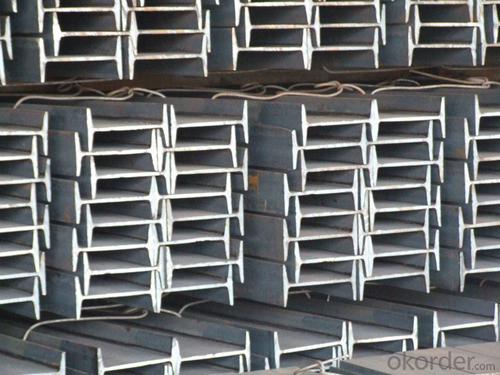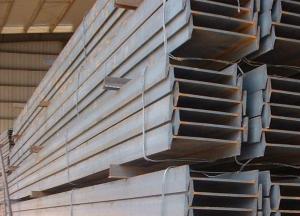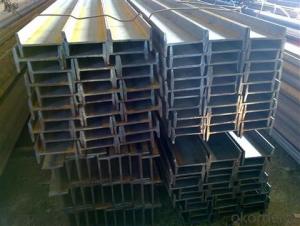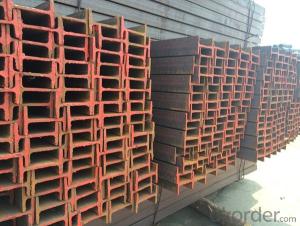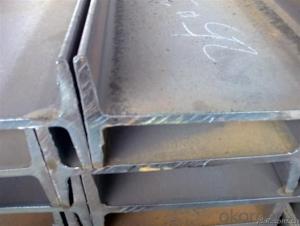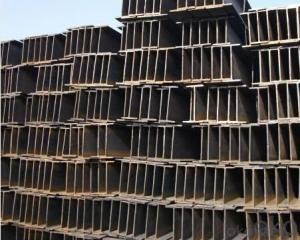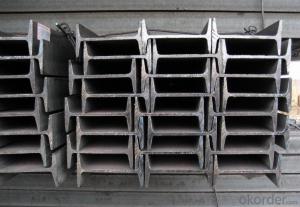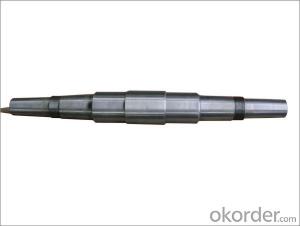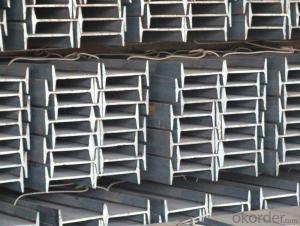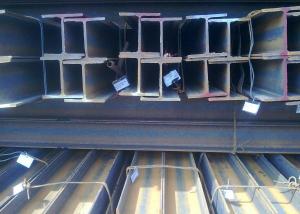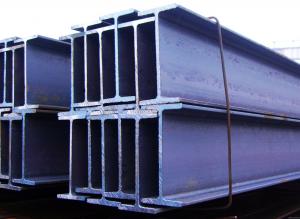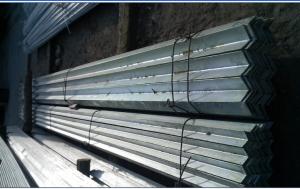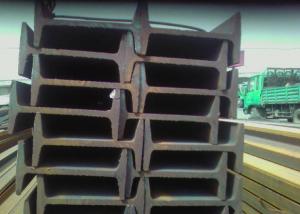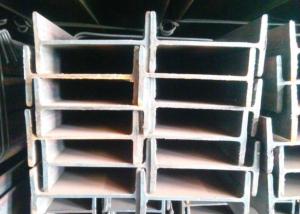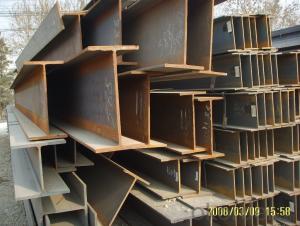Hot Rolled Structural Steel I-Beam
- Loading Port:
- Qingdao
- Payment Terms:
- TT or LC
- Min Order Qty:
- 2000 PCS
- Supply Capability:
- 30000 PCS/month
OKorder Service Pledge
OKorder Financial Service
You Might Also Like
OKorder is offering high quality Hot Rolled Structural Steel I-Beams at great prices with worldwide shipping. Our supplier is a world-class manufacturer of steel, with our products utilized the world over. OKorder annually supplies products to European, North American and Asian markets. We provide quotations within 24 hours of receiving an inquiry and guarantee competitive prices.
Product Applications:
Hot Rolled Structural Steel I-Beams are ideal for structural applications and are widely used in the construction of buildings and bridges, and the manufacturing, petrochemical, and transportation industries.
Product Advantages:
OKorder's Steel I-Beams are durable, strong, and resist corrosion.
Main Product Features:
· Premium quality
· Prompt delivery & seaworthy packing (30 days after receiving deposit)
· Corrosion resistance
· Can be recycled and reused
· Mill test certification
· Professional Service
· Competitive pricing
Product Specifications:
Manufacture: Hot rolled
Grade: Q235, Q345, SS400, S235JR, S275JR, S355JR
Standard: GB, JIS, ASTM ST
Certificates: ISO, SGS, BV, CIQ
Length: 5.8m – 12m, as per customer request
Surface: Painted, galvanized, punched
Packaging: Export packing, nude packing, bundled
Place of Origin: Hebei, China
No. | Depth*Flange Width (mm) | Web Thickness (mm) | Weight (Kg/m) |
10 | 100X68 | 4.5 | 11.261 |
12* | 120X74 | 5.0 | 13.987 |
14 | 140X80 | 5.5 | 16.890 |
16 | 160X88 | 6.0 | 20.513 |
18 | 180X94 | 6.5 | 24.143 |
20a | 200X100 | 7.0 | 27.929 |
20b | 200X102 | 9.0 | 31.069 |
22a | 220X110 | 7.5 | 33.070 |
22b | 220X112 | 9.5 | 36.524 |
25a | 250X116 | 8.0 | 38.105 |
25b | 250X118 | 10.0 | 42.030 |
28a | 280X122 | 8.5 | 43.492 |
28b | 280X124 | 10.5 | 47.888 |
30a* | 300X126 | 9.0 | 48.084 |
30b* | 300X128 | 11.0 | 52.794 |
32a | 320X130 | 9.5 | 52.717 |
32b | 320X132 | 11.5 | 57.741 |
36a | 360X136 | 10.0 | 60.037 |
36b | 360X138 | 12.0 | 65.689 |
40a | 400X142 | 10.5 | 67.598 |
40b | 400X144 | 12.5 | 73.878 |
IPEAA 80 | 78*46 | 3.2 | 4.95 |
IPE180 | 180*91 | 5.3 | 18.8 |
FAQ:
Q1: Why buy Materials & Equipment from OKorder.com?
A1: All products offered byOKorder.com are carefully selected from China's most reliable manufacturing enterprises. Through its ISO certifications, OKorder.com adheres to the highest standards and a commitment to supply chain safety and customer satisfaction.
Q2: How do we guarantee the quality of our products?
A2: We have established an advanced quality management system which conducts strict quality tests at every step, from raw materials to the final product. At the same time, we provide extensive follow-up service assurances as required.
Q3: How soon can we receive the product after purchase?
A3: Within three days of placing an order, we will begin production. The specific shipping date is dependent upon international and government factors, but is typically 7 to 10 workdays.
Q4: What makes stainless steel stainless?
A4: Stainless steel must contain at least 10.5 % chromium. It is this element that reacts with the oxygen in the air to form a complex chrome-oxide surface layer that is invisible but strong enough to prevent further oxygen from "staining" (rusting) the surface. Higher levels of chromium and the addition of other alloying elements such as nickel and molybdenum enhance this surface layer and improve the corrosion resistance of the stainless material.
Q5: Can stainless steel rust?
A5: Stainless does not "rust" as you think of regular steel rusting with a red oxide on the surface that flakes off. If you see red rust it is probably due to some iron particles that have contaminated the surface of the stainless steel and it is these iron particles that are rusting. Look at the source of the rusting and see if you can remove it from the surface.
Images:

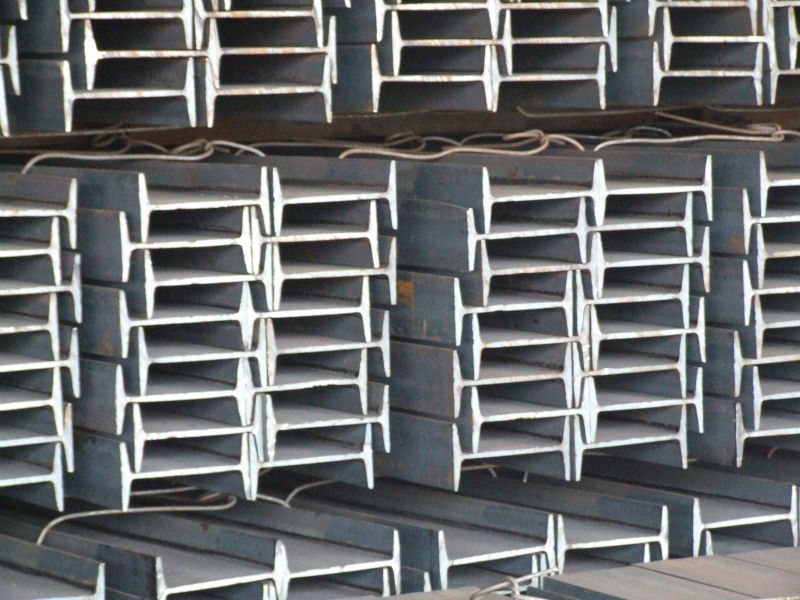
- Q: Can steel I-beams be used in energy-efficient building designs?
- Yes, steel I-beams can be used in energy-efficient building designs. Steel is a durable and versatile material that can support large loads and provide structural stability. It can be incorporated into energy-efficient building designs by using insulated panels, efficient glazing systems, and incorporating renewable energy sources. Additionally, steel is recyclable, which aligns with sustainable practices in construction.
- Q: How do steel I-beams contribute to the overall sustainability of a construction project?
- Steel I-beams contribute to the overall sustainability of a construction project in several ways. Firstly, steel is a highly durable and long-lasting material. Steel I-beams have a lifespan of several decades and can withstand extreme weather conditions and heavy loads without deteriorating. This longevity reduces the need for frequent replacement and repairs, reducing waste and conserving resources in the long run. Secondly, steel is a highly recyclable material. Steel I-beams can be easily recycled at the end of their lifespan, with the recycled steel being used to create new products. This recycling process significantly reduces the demand for raw materials and energy required for steel production, leading to a lower carbon footprint. Moreover, steel I-beams are lightweight compared to other construction materials such as concrete. This reduces the weight load on the foundation and overall structure, resulting in reduced materials and less energy consumption during construction. Additionally, the lightweight nature of steel I-beams allows for more efficient transportation, reducing fuel consumption and greenhouse gas emissions during transportation. Furthermore, steel I-beams are versatile and can be prefabricated off-site. This reduces construction waste and minimizes the impact on the surrounding environment during the construction process. Prefabrication also allows for faster construction, reducing the overall project timeline and minimizing disruption to the surrounding community. Lastly, steel I-beams can be designed and engineered to optimize energy efficiency. They can be integrated with insulation materials, thermal breaks, and other energy-saving features to enhance the overall energy performance of a building. This leads to reduced energy consumption for heating and cooling, resulting in lower operational costs and a smaller environmental footprint. In conclusion, steel I-beams contribute to the overall sustainability of a construction project through their durability, recyclability, lightweight nature, versatility, and potential for energy efficiency. They promote responsible resource use, waste reduction, and energy conservation, making them an environmentally-friendly choice for construction.
- Q: What are the common architectural finishes available for steel I-beams?
- Steel I-beams have a variety of architectural finishes to choose from, each with its own benefits and aesthetic qualities. 1. Paint: A popular choice for steel I-beams is painting, which provides a protective coating against corrosion and adds color. It allows for customization with different colors and finishes like gloss, matte, or textured, ensuring it matches the overall design scheme. 2. Galvanizing: Another option is galvanizing, a process that coats steel I-beams with a layer of zinc. This finish offers excellent corrosion resistance, making it suitable for outdoor or high-moisture environments. The appearance can range from shiny to matte, depending on the desired aesthetic. 3. Powder coating: A dry finishing process called powder coating involves electrostatically applying powdered paint to the steel I-beams. The beams are then heated to fuse the powder, resulting in a durable, smooth, and uniform finish. Powder coating provides a wide range of color options and enhanced protection against scratches and fading. 4. Anodizing: Anodizing is commonly used for aluminum I-beams but can also be applied to steel with specific treatments. This finish creates a protective oxide layer on the surface, improving corrosion and wear resistance. Anodized finishes can be clear or colored, offering a sleek and modern appearance. 5. Stainless steel: For a more upscale and contemporary look, stainless steel I-beams are a great choice. They have a naturally shiny and reflective finish, adding elegance to any architectural design. Stainless steel is highly resistant to corrosion, making it suitable for both indoor and outdoor applications. These are just a few of the architectural finishes available for steel I-beams, each with its own advantages in terms of aesthetics, protection, and durability. The choice of finish depends on project requirements, budget, and desired visual impact.
- Q: How do steel I-beams perform in areas with high levels of UV radiation?
- Steel I-beams generally perform well in areas with high levels of UV radiation. UV radiation can cause damage and degradation to many materials, including wood, plastic, and some metals. However, steel is known for its durability and resistance to UV radiation. Steel is typically coated with protective layers to prevent corrosion and enhance its resistance to environmental factors, including UV radiation. These coatings, such as galvanization or paint, act as a barrier between the steel and the UV rays, preventing direct exposure and potential damage. Additionally, steel has a high melting point and is not easily affected by the heat generated by UV radiation. Furthermore, the structural design of I-beams adds to their ability to withstand UV radiation. The shape of the I-beam allows for efficient weight distribution and load-bearing capacity, making them less susceptible to warping or distortion due to UV exposure. That being said, prolonged exposure to intense UV radiation over many years can still have some impact on steel I-beams. The protective coatings may eventually wear off, exposing the steel to direct UV radiation, which can lead to some corrosion or surface degradation. However, proper maintenance, such as regular inspections, cleaning, and reapplication of protective coatings, can mitigate these effects and ensure the longevity of steel I-beams in high UV radiation areas. In summary, steel I-beams are generally well-suited for areas with high levels of UV radiation due to their inherent durability and resistance to UV damage. With proper maintenance and protective coatings, steel I-beams can effectively withstand the challenges posed by UV radiation, ensuring their structural integrity and longevity.
- Q: Can steel I-beams be used for historical preservation projects?
- Yes, steel I-beams can be used for historical preservation projects. While traditional building materials like wood or stone are often associated with historical structures, steel I-beams have become a common choice due to their durability, strength, and versatility. Steel I-beams are well-suited for supporting heavy loads and can be customized to fit various architectural designs. In historical preservation projects, steel I-beams are typically used to reinforce and stabilize existing structures. They can be installed discreetly within the building to provide structural support without compromising the aesthetic or historical integrity. Additionally, steel I-beams can be used to replace deteriorated or damaged wooden or stone beams, ensuring the safety and longevity of the structure. One advantage of using steel I-beams in historical preservation is their resistance to environmental factors such as moisture, pests, and fire. These beams are typically treated to prevent corrosion, making them ideal for withstanding the test of time. Moreover, steel is a sustainable and recyclable material, aligning with modern conservation practices. However, it is crucial to strike a balance between preserving historical authenticity and incorporating modern materials. In some cases, the use of steel I-beams may be limited to sections that are not visible or can be concealed, as the visual impact of these beams may not align with the original architectural style. A thorough assessment and consultation with preservation experts are necessary to ensure that the use of steel I-beams respects the historical value of the structure while providing the necessary structural support. Overall, steel I-beams can play a vital role in historical preservation projects by enhancing the stability and longevity of structures while maintaining their original aesthetic appeal. With proper planning and execution, these beams can successfully contribute to the preservation of historical buildings for generations to come.
- Q: It's not clear what difference between I-beam and channel steel What's the difference between the formulas for the two materials?
- Different from H steel and I-beam, H steel is better than I-beamGB_706-1988_ dimensions, shape, weight and allowable deviation of hot rolled I-beamGB_T_11263-2005_ hot rolled H and split T section steel
- Q: Are there any design considerations for incorporating steel I-beams in sustainable buildings?
- Yes, there are several design considerations for incorporating steel I-beams in sustainable buildings. One of the key considerations is the use of recycled or reclaimed steel for the production of I-beams. By using recycled steel, the environmental impact of steel production can be reduced significantly, as it requires less energy and emits fewer greenhouse gases compared to the production of new steel. Another important consideration is the use of high-strength steel in I-beams, which allows for the reduction of the overall amount of steel required in the building's structure. This not only reduces the environmental footprint of the building but also decreases costs and construction time. Additionally, the design of the I-beams should consider their end-of-life cycle. Steel is a highly recyclable material, so ensuring that the I-beams can be easily disassembled and recycled at the end of their life is crucial for sustainable building practices. Moreover, the design of the building should optimize the structural efficiency of the I-beams. This can be achieved through various techniques such as proper spacing, sizing, and orientation of the beams, as well as employing advanced engineering software and analysis tools. By maximizing the load-bearing capacity of the I-beams, the overall amount of steel required for the building can be minimized, leading to reduced environmental impacts. Lastly, the integration of steel I-beams with other sustainable building materials and systems should be considered. For example, incorporating I-beams with energy-efficient insulation, renewable energy systems, and water-saving technologies can further enhance the sustainability of the building. In conclusion, incorporating steel I-beams in sustainable buildings involves considering the use of recycled or reclaimed steel, utilizing high-strength steel, optimizing structural efficiency, designing for end-of-life recyclability, and integrating with other sustainable building materials and systems. These considerations help minimize the environmental impact and maximize the overall sustainability of the building.
- Q: Can steel I-beams be used for cantilever structures?
- Yes, steel I-beams can be used for cantilever structures. Cantilever structures are designed to have one end anchored or supported while the other end extends outwards, creating an overhang. Steel I-beams are often used in cantilever structures due to their strength, rigidity, and ability to span long distances. The I-shape provides excellent load-bearing capabilities, allowing the beam to support the weight and distribute the load evenly. Additionally, steel I-beams can be easily fabricated and customized to meet specific project requirements, making them a popular choice for cantilever structures in various applications such as bridges, balconies, and building façades.
- Q: Can steel I-beams be used for both residential and commercial construction?
- Yes, steel I-beams can be used for both residential and commercial construction. They are commonly used in both types of construction due to their strength, durability, and ability to support heavy loads.
- Q: How do I weld 3 steel plates into I-beam?
- The specific process in accordance with the above method to compile the process, select the electrode, usually use manual electric arc welding, welding and assembly can be used after the whole assembly welding, high efficiency to do so, but when welding workpiece rigidity, easy to crack, but also can be used two times forming and welding approach, namely the first floor and the middle the vertical plate welding, welding significantly less rigidity, such as bending deformation after welding is obvious, timely correction, and then welding another piece of plate (for welding to create good working conditions, semi-finished products will have a good welding reverse welding).
Send your message to us
Hot Rolled Structural Steel I-Beam
- Loading Port:
- Qingdao
- Payment Terms:
- TT or LC
- Min Order Qty:
- 2000 PCS
- Supply Capability:
- 30000 PCS/month
OKorder Service Pledge
OKorder Financial Service
Similar products
Hot products
Hot Searches
Related keywords


